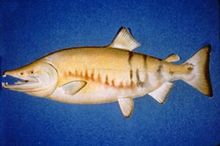- Chum salmon
-
"Keta" redirects here. For the Myst character, see Myst (series).
Chum salmon 
Scientific classification Kingdom: Animalia Phylum: Chordata Class: Actinopterygii Order: Salmoniformes Family: Salmonidae Genus: Oncorhynchus Species: O. keta Binomial name Oncorhynchus keta
(Walbaum, 1792)The chum salmon, Oncorhynchus keta, is a species of anadromous fish in the salmon family. It is a Pacific salmon, and may also be known as dog salmon or Keta salmon, and is often marketed under the name Silverbrite salmon. The name Chum salmon comes from the Chinook Jargon term tzum, meaning "spotted" or "marked", while "Keta" comes from the Evenki language of Eastern Siberia via Russian.
Contents
Appearance
They have an ocean coloration of silvery blue green. When adults are near spawning, they have purple blotchy streaks near the caudal fin. Spawning males typically grow an elongated snout or kype and have enlarged teeth. Some researchers speculate these characteristics are used to compete for mates.
Spawning
Most Chum salmon spawn in small streams and intertidal zones. Some Chum travel more than 3,200 km (2,000 mi) up the Yukon River. Chum fry migrate out to sea from March through July, almost immediately after becoming free swimmers. They spend one to three years traveling very long distances in the ocean. These are the last salmon to spawn (November to January). They die about two weeks after they return to the freshwater to spawn. They utilize the lower tributaries of the watershed, tend to build nests called redds, really little more than protected depressions in the gravel, in shallow edges of the watercourse and at the tail end of deep pools. The female lays eggs in the redd, the male sprays sperm on the eggs, and the female covers the eggs with gravel. The female can lay up to 4000 eggs.
Age
Chum can live from 6 to 7 years, and chum in Alaska mature at the age of 5 years.
Distribution
Chum salmon have the largest natural range of any Pacific salmon, and undergo the longest migrations within the genus Oncorhynchus, far up the Yukon River and deep into the Amur River basin in Asia. In lesser numbers they migrate thousands of kilometres up the Mackenzie River.[1] Chum are found around the north Pacific, in the waters of Korea, Japan, and the Okhotsk and Bering seas (Kamchatka, Chukotka, Kuril Islands, Sakhalin, Khabarovsk Krai, Primorsky Krai), British Columbia in Canada, and from Alaska to California in the United States. In in Arctic Ocean they are found in limited numbers from the Laptev Sea to the Beaufort Sea.[1]
Sizes
Adult chum usually weigh from 4.4 to 10.00 kg, with an average length of 60 cm. The record for chum is 19 kg and 112 cm and was caught at Edie Pass in British Columbia.
Diet
Juvenile chum eat zooplankton and insects. Recent studies show that they also eat comb jellies. As adults, they eat smaller fish.
Commercial use and value
The chum salmon is the least commercially valuable salmon. Despite being extremely plentiful in Alaska, commercial fishers often choose not to fish for them because of their low market value. Recent market developments have increased the demand for Chum salmon. Markets developed for chum from 1984 to 1994 in Japan and northern Europe which increased demand.[citation needed] They are a traditional source of dried salmon.
Conservation
There are few healthy groups of chum remaining in North America outside of Alaska.[citation needed] This is partially because of dams, which block the free flow of the water and the migration of the fish.
Two populations of Chum have been listed under the U.S. Endangered Species Act, as threatened species. These are the Hood Canal Summer Run population and the Lower Columbia River Population.
Susceptibility to diseases
Chum are thought to be fairly resistant to whirling disease, but it is unclear.
See also
References
- National Marine Fisheries Service chum salmon web page
- "Oncorhynchus keta". Integrated Taxonomic Information System. http://www.itis.gov/servlet/SingleRpt/SingleRpt?search_topic=TSN&search_value=161976. Retrieved 24 January 2006.
- Froese, Rainer, and Daniel Pauly, eds. (2005). "Oncorhynchus keta" in FishBase. 10 2005 version.
- Encarta Encyclopedia 2004
- Alaska Department of Fish and Game
- National Marine Fisheries Service ESA Listings
Categories:- Arctic freshwater fish
- Salmon
- Cold water fish
- Fish of the Pacific Ocean
- Fish of Japan
- Oncorhynchus
Wikimedia Foundation. 2010.


